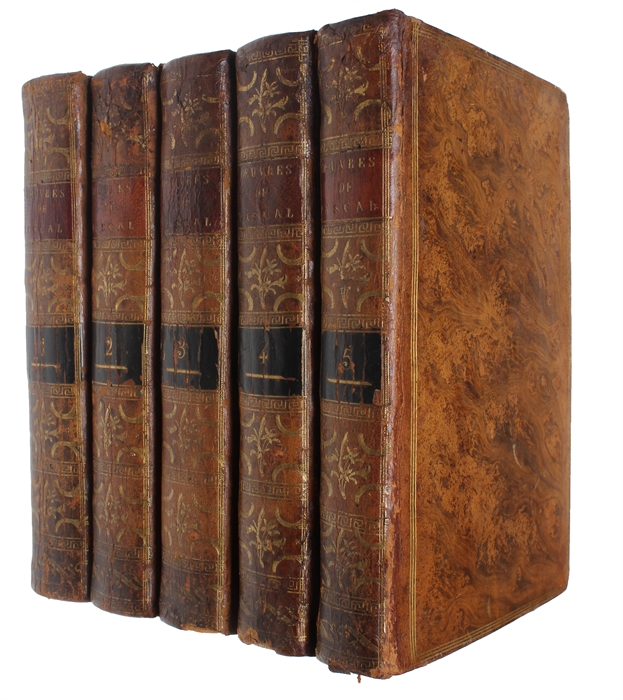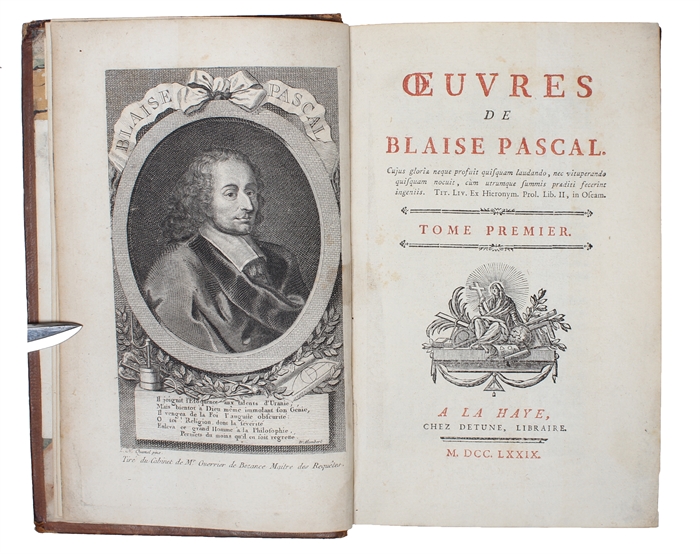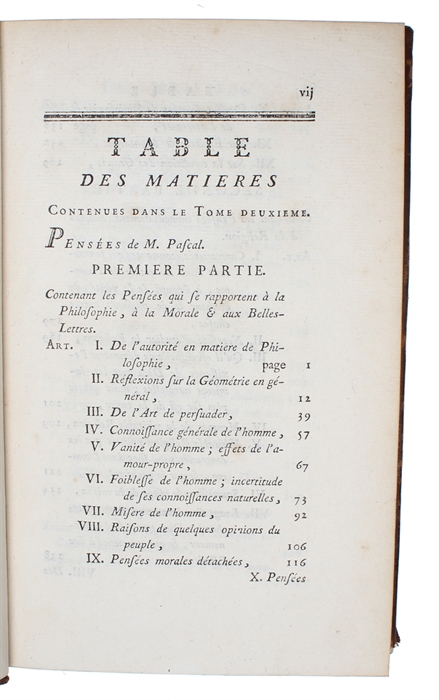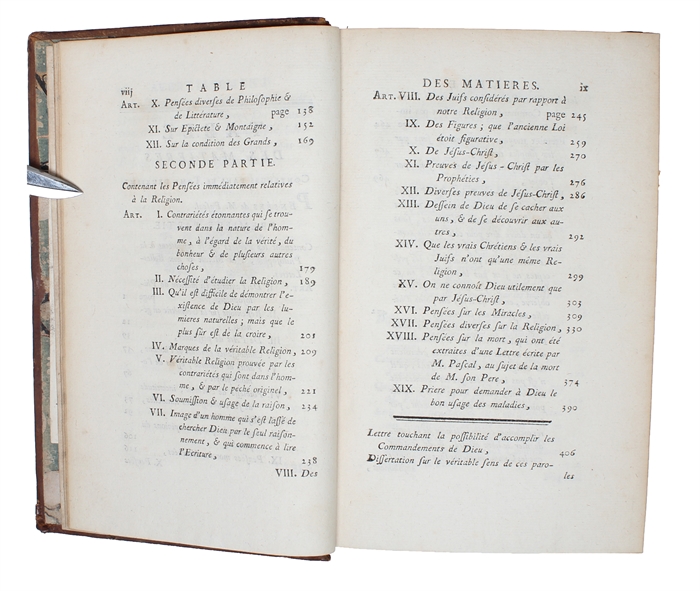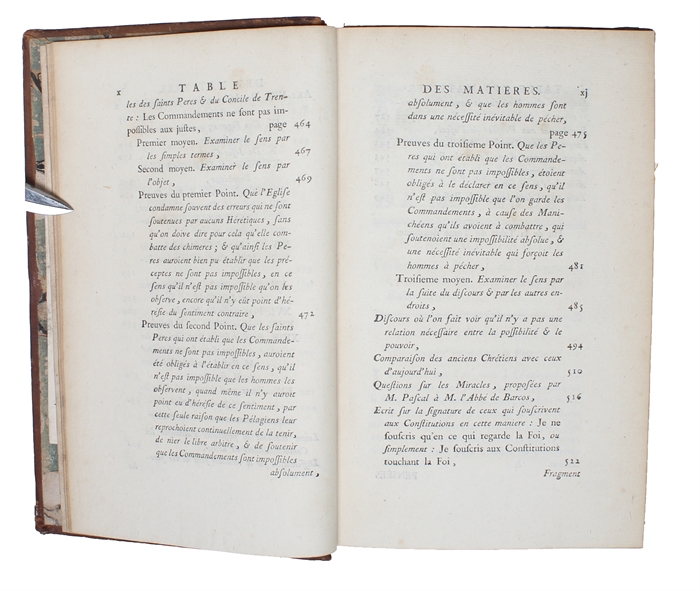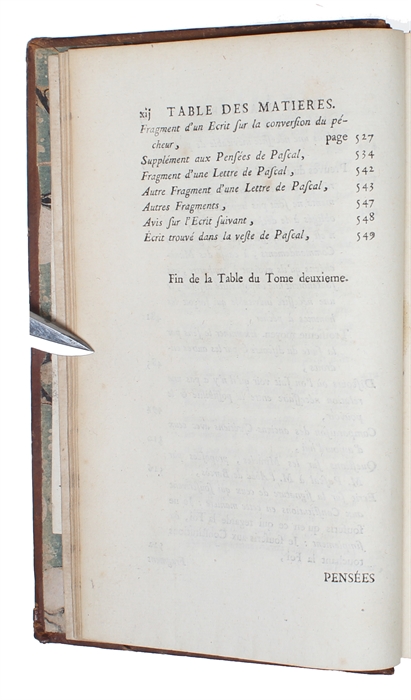PASCAL, BLAISE.
Oeuvres. (Edited by C. Bossut). 5 vols.
La Haye, Dètune, 1779. 8vo. Five very nice contemporary full mottled calf bindings with gilt title- and tome-labels to richly gilt backs, triple gilt line-borders to boards and single gilt line-ornamentation to edges of boards. Marbled adges. Minor repairs to a few capitals, but overall a very nice copy indeed. Internally very nice, clean, and fresh; printed on good paper. One leaf of volume one with neatly closed tear. Old owner's name to title-page of volume 5. Title-pages printed in red and black. With book-plates of Fritz Trieboe/Twilboe (?), A. Gedeon, and C. Rasch. Frontis-piece portrait, 425 pp.; XII, 549 pp. (last leaf uncut an folded); VIII, 526 pp.; VIII, 456 pp. + 9 engraved plates, of which 8 are folded; VIII, 462 pp. + 5 folded engraved plates, (1) p (directions for the book binder. In all 14 engraved plates, of which 13 are folded.
Scarce first edition of Pascal's collected works, comprising much significant material printed for the first time as well as the second appearance of the announcement of Pascal's groundbreaking calculating machine, the first edition (privately printed) of which from 1645 is impossibly scarce, making this the earliest obtainable edition of the seminal text.
"Pascal designed his first mechanical adding machine in 1642. He was not the first to design and construct a mechanical calculator..." but in contrast to Schickard's accomplishments which were destined for a history of obscurity, Pascal, in contrast, "constructed about fifty examples of his machine, of which several are extant; and the machine was well known to the cognoscenti, both through Pascal's own efforts (he hoped to make a profit selling them) and through Diderot's later description of it in the "Encyclopédie" (1751)... In 1645 Pascal published an eighteen-page pamphlet - now extremely rare - describing his calculating machine... The pamphlet does not identify a place of printing or a printer's name, so we may assume that Pascal himself paid for its printing. When we wrote this bibliography, OCLC cited only two copies of this pamphlet in one French library and no copies and North America." The pamphlet was reprinted, along with additional material, in volume IV (pp. 7-30) of the present "Oeuvres". The additional material consists of Pascal's 1650 letter to Queen Christina of Sweden; the privilege for its construction and sale issued in 1649 and published for the first time here ; and Diderot's description of it for the "Encyclopédie", along with two plates.
Also of interest here is the reprint of Pascal's 1654 paper introducing his triangle of binominal coefficients (Pascal's Triangle), included in Volume V, pages 1-54. Pascal's invention "predated the concepts of computation of the values of polynomial functions by differences." (Lee 1995, 538)." (Origins of Cyberspace No. 13).
In the present edition the Pascal-Noël correspondence on the vacuum is also printed for the first time, along with other pieces on the vacuum as well as his correspondence with Fermat and deRibeyre.
Origins of Cyberspace: 13.
Brunet: IV,395;
Tchemerzine: IX, p78, f): "Les Oeuvres Scientifiques de Pascal sont recueillies dans l'édition des Oeuvres, La Haye, chez Detune, libraire, 1779. 5 vol. in 8. Titre rouge et noir. Publiée par l'Abbé Bossut. Les oeuvres scientifiques occupent les tomes IV et V."
Order-nr.: 41493

